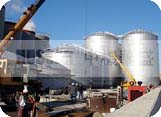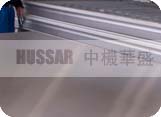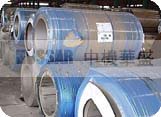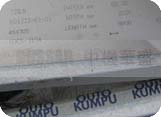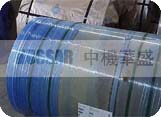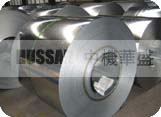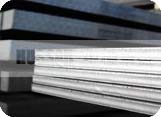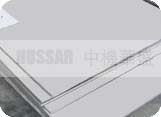| 2304 (UNS S32304)
duplex stainless steel
---------------------------------------------------------------- General
Properties
Alloy 2304 is a 23% chromium, 4% nickel, molybdenum-free duplex
stainless steel. The Alloy 2304 has corrosion resistance properties similar to
316L. Furthermore, its mechanical properties, i.e., yield strength, are twice
those of 304/316 austenitic grades. This allows the designer to save weight, particularly
for properly designed pressure vessel applications. The
alloy is particularly suitable for applications covering the -50C/+300C (-58F/572F)
temperature range. Lower temperatures may also be considered but need some restrictions,
particularly for welded structures. With
its duplex microstructure and low nickel and high chromium contents, the alloy
has improved stress corrosion resistance properties compared to 304 and 316 austenitic
grades. ---------------------------------------------------------------- Applications
Generally
where 304 and 316L are used
Pulp and paper industry (chip storage tanks,
white and black liquor tanks, digestors)
Caustic solutions, organic acids
(SCC resistance)
Food industry
Pressure vessels (weight savings)
Mining (abrasion/corrosion)
---------------------------------------------------------------- Standards
ASTM/ASME.......... A240 - UNS S32304
EURONORM...........1.4362 - X2 Cr Ni
23.4
AFNOR...................Z3 CN 23.04 Az
DIN.........................W.
Nr 1.4362 ---------------------------------------------------------------- Corrosion
Resistance
General Corrosion
Because of its high chromium content
(23%) the corrosion resistance properties of 2304 are almost equivalent to those
of 316L. Localized Corrosion Resistance
The 23% chromium and 0.1% nitrogen additions explain why 2304 duplex stainless
steel behaves much better than Alloy 316L when considering pitting and crevice
corrosion resistance.
Stress
Corrosion Resistance
Stress corrosion resistance test results in chloride
containing aqueous solutions ((8ppm 02) PH =7, >1000 h, applied stresses higher
than the yield strength) show that Alloy 2304 outperforms Alloys 304L and 316L,
due to its high chromium additions and low nickel contents. This
is a typical feature of duplex stainless steels. Alloy 2205 performs still better
than 2304 in similar conditions. Other
Corrosion Resistance Properties
Alloy 2304 duplex stainless steel successfully
passes most of the standard IC test procedures such as ASTM, A262E, and C tests.
Its corrosion rate in boiling nitric acid (65%) is higher than that of Alloy 316L.
Due to its high yield strength, the alloy performs well in abrasion/corrosion
applications.
----------------------------------------------------------------
Chemical
Analysis
Typical values (Weight %) C
Cr Ni Mo N Others
0.020 23 4 0.2 0.1 S = 0.001
PREN (Cr%) + 3.3 (Mo%)
= 16 (N%) ≥ 24
---------------------------------------------------------------- Structure
The chemical analysis of 2304 is optimized to obtain a typical 50 a / 50 g microstructure
after solution annealing treatment at 950/1050C (1742/1922F). The
microstructure of 2304 duplex is very stable compared to molybdenum-containing
duplex stainless steels. Intermetallic phases are present only after 10 hours
holding time in the 750/850C (1382/1562F) temperature range. Copper additions
to 2304 grade, when specified, increase the hardness of the steel after heat treatment
in the 350/500C (662/932F) temperature range. ----------------------------------------------------------------
Hot forming
Hot forming must be performed in the 1150/900C (2100/1650F)
temperature range. After forming, a new solution annealing treatment is recommended
in the 950/1050C (2100/1650F) temperature range to fully restore corrosion resistance
properties and mechanical properties. Parts formed with 2304 must be supported
carefully during heating to avoid creep deformation. Cold
forming
Alloy 2304 may be cold formed without any problem. The same equipment
as used for the cold forming of 304L and 316L grades can be used. Due to its higher
mechanical properties, including the yield strength, higher stresses are required
for cold forming. A final solution annealing heat treatment is also recommended
after cold forming in order to restore the mechanical and corrosion resistance
properties, as decribed in ‘hot forming.’ Descaling
Use the same solutions and pastes as for Alloys 304L/316L. The pickling time will
be higher than for austenitic grades due to the corrosion resistance properties
of the alloy. ---------------------------------------------------------------- Machinability
Alloy 2304 duplex exhibits improved machinability properties particularly when
considering drilling. Its behavior is equivalent to that of 316LEZ*. Furthermore,
2304 has better corrosion resistance and cleanliness properties as no sulphur
additions are necessary. Localized corrosion resistance behavior is improved. *316LEZ
is a 316L type grade with improved machinability properties.
---------------------------------------------------------------- Welding
Alloy
2304 can be successfully welded by the following processes :
TIG, manual
and automatic
PLASMA, MIG, SMAW, SAW, FCAW
The duplex microstructure
renders the alloy less sensitive to hot cracking.
The welding parameters
must be optimized to obtain a controlled ferrite level (20-70%). Typical recommended
heat inputs are 10-25 KJ/cm with a 150C (302F) max interpass temperature. These
conditions must be optimized taking into account the thickness of the products
and welding equipment (consult if necessary). We do not recommend pre- or post-welding
heat treatments. Only complete solution annealing heat treatment may be considered.
| 
